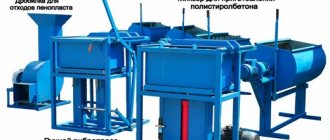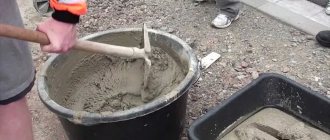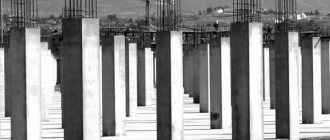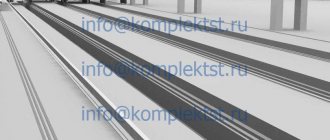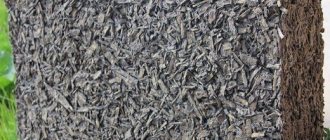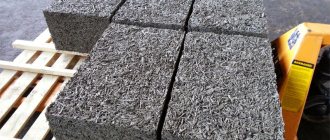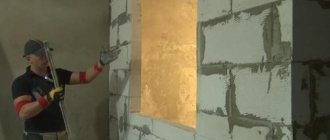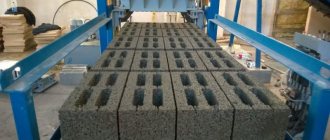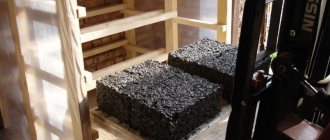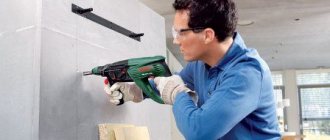The Russian market for the construction of private low-rise houses and cottages, if not experiencing a boom as in previous times, still has a positive growth of approximately 3-4% per year, occupying almost half (43%) of the entire new housing market in the country.
In addition, the trend of using increasingly modern and easy-to-process structural and building materials in the construction of private houses, which includes foam concrete mixtures and foam blocks, has become quite firmly established.
The attractiveness of using foam blocks as a building material is determined by its characteristics, such as:
- has the best thermal insulation properties, which is primarily ensured by the presence of the cellular structure of foam concrete, where the voids are filled with air bubbles.
- environmental friendliness, since the production of foam concrete mainly uses natural components and raw materials.
- foam concrete has high resistance to moisture, i.e. low hygroscopicity, which determines its immunity to external weather factors, especially in conditions of high humidity, for example, in coastal or marine areas.
In addition, the attractiveness of foam concrete and building materials made from it is ensured by its relatively simple production technology, allowing even small enterprises and individual entrepreneurs to engage in this business.
Relatively simple technology, coupled with growing demand, makes the business of producing foam blocks profitable in any regional and even local construction market.
About foam block and materials
Today, it is not necessary to hire hired workers to build a summer cottage extension.
For example, you can do it yourself:
- make brickwork;
- fill the floors;
- cover the roof.
In this case, we will talk about the production of foam blocks, which will be used as the main building material. The price for them is quite affordable, however, if you have the necessary technical knowledge, you have every chance to save money even at this stage. The production of foam blocks usually has a 300% profitability, and it can be organized without any special material investments.
In the photo - organization of independent production of foam blocks
Foam block is called foam concrete, which is enclosed in a certain shape. Before you learn how to make it yourself, you should master the process of producing foam concrete.
Prepare the following materials for work:
- cement M400 and higher, but avoid any additives in its composition;
- sand, but remember that when making thermal insulating concrete, it is not needed; if a concrete density of 550 kg/m3 or higher is required, add crushed or natural sand;
- water;
- foaming agent (add foam to a homogeneous mixture, its density is from 80-85 g/m3: if it is less, the number of pores in the foam block will increase, and this will cause its rapid destruction;
- special equipment.
Equipment for the production of foam concrete at home
Technology
| Materials for 1 m3 of foam concrete | · sand ≈ 220 kg; · cement – 350 kg; · foaming agent – 1-1.5 l; · water in the required quantity. |
| Equipment | 1. Foam generator.2. Compressor.3. Concrete mixer.4. Forms for foam blocks. |
If you think that you will need a lot of materials to make foam concrete, we hasten to please you, the costs will be significantly lower than when buying branded foam blocks. Cement is the most expensive, other components are only a quarter of the total cost.
Continuous foam concrete manufacturing technology
Agree, the picture is quite interesting, but one should also take into account the difficulties that may arise during the production of foam concrete blocks, which may entail additional costs. It is also necessary to calculate the costs of special equipment, as well as the fact that you will be making foam concrete for the first time. There is also a high probability that you will not be able to achieve the required quality of the solution the first time.
Pay special attention to the shapes, since the future appearance of the foam blocks and their overall dimensions will depend on them. Among them, the main parameter is the width, since it affects the thickness of the masonry
Production of foam concrete blocks by pouring into molds
If you decide to build a garage, 200 mm is enough; when building a house, it cannot be less than 300 mm. You can make the necessary equipment yourself or buy it in a retail chain.
It should be said right away that the purchased device may sometimes not suit you due to a number of characteristics, then you will have to modify it yourself. The easiest way is to make forms for foam concrete blocks using any material, but it must have 2 main qualities - evenness and maintain dimensions under the weight of concrete.
Making forms
They should be cells in a large box with dimensions corresponding to the dimensions of the future block.
They can be made from:
- metal;
- plywood;
- boards
Metal mold
The main advantage of making foam blocks yourself is the arbitrary shape and size of the finished product. Products with dimensions of 600x300x300 mm are suitable for building a house, although you can use others, but you must obey the rule - the length must be a multiple of the width or height.
Example of a plywood mold
- We cut out a bottom from a plywood sheet, the dimensions of which correspond to the length and width of the box.
- We also manufacture its outer walls.
- We knock down 5 plywood pieces so that they resemble a box. In this case, its dimensions must be made slightly larger than a multiple of the length and width of the numbers. This is due to the thickness of the partitions, which should also be taken into account.
For example, with a length of 1500 mm, 5 blocks and 4 partitions between them will fit in a box. The width of the form is also calculated.
- Install the partitions into the finished box and secure with nails.
- Cover the partitions with polyethylene before filling the form with concrete. This will protect the plywood from moisture, and it will be easier to remove the finished block from the cell without even disassembling it. For independent work, it is enough to make about 60 or fewer cells.
Technology for producing foam blocks at home
The technology for producing foam blocks at home involves performing the following work:
The longer the composition is mixed, the more the foam is destroyed, which is unacceptable, since it is fraught with a significant decrease in the strength and other characteristics of the finished foam concrete
- Preparation of starting components in quantities corresponding to the recipe.
- Preparation of the required volume of foam concentrate from foam concentrate.
- Mixing cement-sand mortar in a concrete mixer.
- Adding water and introducing foam, followed by mixing.
- Pouring foam concrete mixture into molding containers.
- Sediment of finished blocks in containers.
- Removing products from molds for further drying.
Making prefabricated molds for foam blocks
Making your own molding box for pouring foam blocks provides the opportunity not to be limited by the standard dimensions of products. When designing a molding container, you should take into account the number of blocks that will be poured at one time.
The following materials are used to make the mold:
- moisture-resistant plywood;
- a metal sheet;
- planed boards.
The process of making a molding container is simple:
- Prepare a working drawing or sketch of the molding box.
- Transfer the sketch dimensions to the material used.
- Cut the side and transverse blanks to the required sizes.
- Cut out the bottom of the molding container.
After making the individual elements, assemble the mold. When using plywood, place polyethylene inside the cells, which makes it easier to remove finished products and protects the material from absorbing moisture. Lubricate the surface of the metal box with waste oil.
Try to make forms with the most correct geometry
Preparation of cement-sand mortar
The process of preparing the sand-cement mixture is carried out according to the following algorithm:
- Clean the sand from impurities using a sieve.
- Weigh the required amount of Portland cement and sand.
- Load the ingredients into the concrete mixer.
- Stir for 5 minutes until smooth.
Which foaming agent to use for foam concrete
The quality of the foaming agent affects the performance characteristics of foam concrete. Various foaming agents are used:
- purchased, offered in specialized stores. They are a concentrate that is diluted to the required state according to the manufacturer’s recommendations;
- self-made. The composition of the homemade foaming agent includes caustic soda in the amount of 0.15 kg, 0.06 kg of wood glue and a kilogram of rosin. The ingredients are mixed under low heat until smooth, followed by adding water.
A self-prepared foaming agent is not inferior in quality to the finished concentrate.
Pour the finished foam concrete solution
Filling molding containers is carried out in various ways:
- manually for small volumes of foam concrete block production;
- using a concrete pump in the production of blocks in industrial quantities.
Paperwork
Preparing papers for the legal production of foam blocks begins with choosing a legal form for your business. LLC registration is carried out if the owner of the company plans to work with government agencies and large companies. Entrepreneurs who focus on working with individuals can register as individual entrepreneurs. In addition, you will need the following documents:
- permits from the fire inspection and Rospotrebnadzor;
- certificates;
- invoices for raw materials;
- agreements with counterparties;
- certificate of opening a bank account.
Preparation of documents for the operation of an enterprise that specializes in the production of foam blocks is almost completely limited to the listed issues. For this line of commercial activity there is no need to obtain permits or licenses. To register a business and subsequent preparation of reporting, banking and other documents, you need to indicate the activity code (according to the all-Russian classifier). In this case, it is OKVED 26.61.
Equipment and tools
When making foam blocks at home, you may need the following equipment and accessories:
- feeding device for cement and sand;
- foam generator with a capacity of at least 200 l/min;
- pressure unit;
- used water dispenser;
- vibrating screen (raw material sifter);
- hose for exiting the finished mixture;
- compressor;
- concrete mixer with a volume of at least 250 liters;
- special molds for blocks or a cutting machine.
Buying the necessary equipment for the production of building materials at home today will not be difficult. If desired, you can purchase not only a complete production line, but also its individual components. It is worth considering that equipment for the production of foam blocks at home can be not only stationary, but also portable. The line can be conveyor or automated. These factors determine the cost of the purchased equipment.
At the heart of any set of equipment is a foam generator. Such a device can produce about 100-110 cubic meters of material per day. A distinctive feature of stationary lines is their high productivity along with excellent quality and low cost. Considering that such a kit will cost approximately 1.5 million rubles, this calls into question its purchase.
A mobile foam concrete plant does not require the purchase of an expensive foam generator, which makes it in demand in the construction market. However, along with this, it cannot boast of high productivity. As a rule, a pressure unit is used in this case, but with all its power it is not capable of producing more than 40-45 cubic meters of finished material per day.
Their strength is inferior to analogues created on fixed lines. The price of a complete set for home production can vary from 50 to 300 thousand rubles. However, as a rule, high-power equipment is more expensive. For example, a kit for 300,000 rubles can produce about 72 cubic meters of foam concrete per day.
An automatic line requires large areas, which is often problematic, because it was not provided for initially. As a rule, such lines require the creation of bunkers for cement, water, sand, as well as additives with automatic dosing. In addition, it is necessary to think about areas for drying foam concrete, pouring it into forms, as well as installation for cutting. This equipment is capable of producing on average about 80-100 cubic meters of material per day, but not everyone can afford such luxury, because the kit will cost from 1.5 to 3 million rubles.
When there is not enough money at the initial stage, they buy used equipment. However, in this case, you should be prepared for the fact that some parts may need to be replaced quite quickly.
The forms purchased for foam concrete can be different. Today they are made of steel, plywood, and plastic. The capacity of the products is different, for example, you can purchase plastic forms with dimensions of 390x190x288 mm, plywood versions with dimensions of 588x300x188 mm, steel analogues with dimensions of 600x300x200 mm
When purchasing them, it is important to take into account the strictness of the geometry, since the quality of the finished material will directly depend on this. Even the slightest violation of symmetry is unacceptable
When choosing molds for pouring foam concrete mass, you should pay attention to the material they are made of.
Considering that the formwork can be combined, this is especially important. For example, if the seller notes that a metal version with heavy-duty plastic inserts can withstand even the highest temperatures, you should not blindly trust this
For example, if the seller notes that a metal version with heavy-duty plastic inserts can withstand even the highest temperatures, you should not blindly trust this.
The fact is that such forms are actually short-lived. During the drying and hardening process of the foam concrete mass, a large amount of heat will be released.
Profitability
In order to calculate the profitability of foam block production, it is necessary to estimate the material cost of the products. As an example, we can consider the production of high-quality blocks of two brands - D600 and D800:
Cost of 1 m³ of foam blocks
| Ingredient | Price, rub./kg (l) | D600 | D800 |
| Sand, kg | 0,45 | 210 | 420 |
| Cement, kg | 4,5 | 310 | 320 |
| Foaming agent, l | 120 | 1,3 | 1,2 |
| Fiber, kg | 170 | 0,5 | 0,5 |
| Water, l | 0,035 | 165 | 165 |
| Hardening accelerator, kg | 55 | 0,5 | 0,5 |
| Mold lubricant, l | 60 | 1 | 1 |
| Film for packaging, m | 1,5 | 16 | 16 |
| Total, rub.: | 1847 | 1975 | |
The selected equipment allows the production of about 30 m³ blocks per shift. If they are fully sold at average market prices, the entrepreneur’s monthly income will exceed 2 million rubles:
Revenue from the sale of foam blocks
| Price, rub./m³ | Per day, m³ | Per month, m³ | Revenue, rub. | |
| Foam block D600 | 3000 | 15 | 330 | 990000 |
| Foam block D800 | 3200 | 15 | 330 | 1056000 |
| Total: | 30 | 660 | 2046000 | |
Taking into account the amount of overhead costs, we can say for sure whether it is profitable to produce foam blocks. In this case, the enterprise’s net profit for the month will be a little more than three hundred thousand rubles:
Profitability of foam block production
| Index | Meaning |
| Revenue, rub. | 2046000 |
| Expenses, rub. | 1690380 |
| Profit, rub. | 355620 |
| Tax simplified tax system 15%, rub. | 53340 |
| Net profit, rub. | 302280 |
| Profitability, % | 17,8 |
| Investments, rub. | 4483260 |
| Payback period, months | 14,8 |
Download Business Plan
Business plan
Making foam blocks as a business is a cost-effective and quite profitable activity, since the demand for this material is constantly growing. However, it is still necessary to conduct an analysis of demand and competition in a particular area in order to determine the number of potential buyers and the production volumes of existing enterprises.
If you plan to open a mini plant for the production of blocks, then you need to purchase special equipment, rent premises and create a business plan.
The area of the premises depends on the planned production volume. For example, to produce 30 m3 of material per day, an area of 300 m2 is required.
Equipment for the production of foam blocks (minimum set, cost):
- concrete mixer (138,000 - 140,000 rubles);
- foam generator (23,000 - 27,000 rubles);
- compressor (approximately 37,000 rubles);
- 20 forms (6,000 - 7,000 rubles).
This means that the entire line for the production of foam concrete blocks will cost from 200,000 rubles.
If concrete hardening is carried out in an autoclave, the price of the equipment will increase significantly
If you purchase a ready-made machine (installation) for production, it is important to choose the right supplier of this equipment. He should help with installation and provide warranty service. Video:
Profitability (expenses / income)
In addition to equipment, you will need a certain number of personnel, as well as general expenses (rent, electricity, water).
If you produce 30 m3 of foam concrete blocks per day, you will need:
- 9300-9600 kg of cement;
- 6300-6600 kg of sand;
- 3000-3300 l of water for cement mortar and 165-180 l of water for foaming agent;
- foam concentrate 45 l.
In monetary terms, this will be approximately 60,000 rubles plus 500 rubles for electricity.
The cost of the foam block also includes wages and rent. This means that producing 30 m3 will cost approximately 66,000 rubles.
You can sell 30 m3 of foam concrete blocks for 90,000 rubles and earn about 24,000 rubles from it.
If you produce 10 m3 daily and sell the products, then you can earn from 200,000 rubles monthly. In this case, the initial costs will pay off in 1-2 months.
Financial side of the issue:
- Creation of a mini-production of foam blocks using injection molding technology using a pressure unit to create a foam concrete mixture. To start such a business, about 300 thousand rubles are enough (if premises are found);
- Mini-production of foam blocks using cutting technology using a foam generator to create a foam concrete mixture. Start-up costs are about 700 thousand rubles;
- Purchase of a line for the production of foam blocks, including a full range of expensive equipment: mixing stations, foam generators, cutting complexes, etc. The purpose of purchasing such a line is to create an enterprise for the production of large volumes of foam blocks. Start-up costs in this case will amount to several million rubles.
Stages of work
If you are interested in how to make foam concrete at home, you need to carefully study the technology for making foam blocks and find the optimal recipe. After this, you can perform the required actions step by step, strictly following the instructions.
Foam solution
Foam concrete technology involves the preparation of cement mortar. It is created in the same way as for traditional concrete. It is recommended to use products under the M400 or M500 brands as a cement mixture.
It is important to make sure that the sand is dry and does not contain unnecessary impurities or additives. To dilute the components, plain water from a centralized water supply system is used. Foam is added to the finished solution
A foam generator is sold in every hardware store or made from improvised materials.
Foam is added to the finished solution. A foam generator is sold in every hardware store or made from improvised materials.
Pouring solution into molds
The next stage is to pour the prepared consistency into prepared forms. Before performing this action, the containers are lubricated with a special solution. Builders know 2 methods of how to make foam blocks with their own hands:
- Molding.
- Cutting.
The first technology involves pouring the solution into the workpieces. When it hardens, you can remove it from the mold and wait another couple of hours for final hardening. Using such a technique has a number of disadvantages. First of all, this is possible damage to the metal, and also deformation of the blocks during removal.
It is quite difficult to install structures with uneven geometry; they are of poor quality and not strong enough. However, the cutting method is more expensive because it requires the purchase of special equipment.
Cutting technology
Production using cutting technology involves dividing the finished slab into several separate sections. Within 6-9 hours, the raw material acquires an optimal degree of strength and can be removed from the formwork. Then the prepared array is moved by a traverse to the cutting equipment, and the specialist begins the cutting process.
The advantage of this technique is the highest accuracy, since the permissible deviation does not exceed 1 mm. The cutting complex is equipped with a special screw for removing the top and twisted strings that cut the material. To obtain different block sizes, the specialist changes the position of the cutting strings. 1 cycle lasts for 5-7 minutes.
After the event is completed, the container with the blocks is placed in a place to dry. After 12-24 hours, depending on the effectiveness of drying, the foam block is removed from the pallet and moved to the storage location.
The technique has the following advantages:
- The geometry of the blocks is smooth and correct.
- The edges have no deviations.
- Any chips or irregularities are excluded.
The disadvantages include:
- Additional costs for purchasing equipment.
- If the concrete does not harden, it will be destroyed when cutting.
Types of markings
In construction, foam blocks of different densities are used, depending on the purpose. This characteristic is denoted by the Latin letter D with a numerical index indicating the weight of a cubic meter of material in kilograms. There are:
- D100 - D Used for the construction of internal partitions of residential and public buildings.
- D400 - D Suitable for insulation and soundproofing of walls, floors and interfloor ceilings.
- D600 - D They are used both for thermal insulation of structures and for the construction of external walls.
- D1000 - D Designed for installation of load-bearing walls, columns, lintels and other structural elements.
According to industry standards, after testing in the laboratory, units may receive additional markings indicating their characteristics:
- The symbol B with numbers indicates the compressive strength of the product. Index values from 0.5 to 60 indicate the load in kgf/cm² that the block can withstand.
- The F symbol with numbers from 15 to 75 indicates frost resistance. The index after it indicates the permissible number of freezing and defrosting cycles.
Buyers pay attention to the technology of drying finished products. Experience shows that it partly affects the strength of the material. There are blocks:
- Autoclaved. After setting, the solution is kept for several hours in a sealed chamber at a temperature of 170–210°C and a pressure of 0.8–1.2 MPa;
- Non-autoclaved. They are dried and ripened for 28 days under natural conditions, at room temperature and humidity.
Foam blocks also differ in size, which allows builders to select them in accordance with the task at hand:
Dimensions of concrete foam blocks
| Dimensions | Quantity per cubic meter |
| 100 × 300 × 600 mm | 55 pcs. |
| 120 × 300 × 600 mm | 46 pcs. |
| 150 × 300 × 600 mm | 37 pcs. |
| 200 × 300 × 600 mm | 27 pcs. |
| 250 × 300 × 600 mm | 22 pcs. |
| 400 × 300 × 600 mm | 20 pcs. |
Finally, foam blocks can be classified according to their purpose during construction work. The assortment looks like this:
- Standard. They have a thickness of 200–300 mm, which allows them to be used to solve any problems.
- For partitions. They differ in thickness of 100–150 mm, and therefore are well suited for arranging interior walls.
- U-shaped. They have the form of a tray into which a reinforcing belt, dressings or utility lines are placed.
- Reinforced. They are blocks and beams reinforced with a steel frame, suitable as lintels.
- Non-standard. They differ in protrusions, cutouts, internal voids or complex shapes. They are mainly produced to order.
Production of foam concrete products in factory conditions: manufacturing features and profitability
The production of foam concrete blocks is a profitable business, which is why the idea of their production attracts the attention of not only economical land owners, but also interested businessmen. Foam concrete production scheme
Foam concrete production scheme
Equipment selection
To organize a company for the production of foam concrete will require considerable expenses. They are associated, first of all, with the purchase of equipment, rental of premises and the purchase of necessary raw materials.
- The minimum set of equipment includes: mixer, foam generator, block molds, compressor, foam concrete pump.
- The best option would be to purchase an automated installation. It almost completely eliminates human intervention. The main advantages of using a comprehensive kit are speed and high quality. The price, of course, is much higher, but the result is corresponding.
- The choice of supplier should be approached with special responsibility. Collaborating with companies that have a proven track record in the manufacturing equipment supply market can fundamentally impact an organization's future success.
To ensure full compliance with the technological process and storage conditions, the organization needs additional technical equipment and the availability of various equipment.
It includes:
- Warehouse space suitable for storing finished blocks;
- Pallets that meet the requirements of State Standards
- Equipment for heat treatment of foam concrete products;
- Automated bunker for cement and sand, capable of filling material in batches;
- Conveyor for sand supply (belt);
- A place for storing sand in which a certain temperature and humidity level must be maintained.
Types of production and technology
The main methods for producing foam concrete in a factory:
- Pressure technology allows you to feed all the necessary components into the mixer under pressure. The components are mixed in the required dosage and the finished solution is supplied at the output, which is sent to the molds. In this case, the use of a foam generator is not required.
- Porization technology allows the process to be carried out directly on the construction site, since this method uses mobile mobile equipment. The foam is made in a parizer, which delivers it through a pipeline, and the finished mixture enters the molds through a hose.
- The classic technology, which was already mentioned above, is also used in production, but the process is more automated. This is the most popular method of all.
Porosizer on wheels
Let's consider how the full cycle of the foam concrete manufacturing process proceeds when using more modern technology rather than home-made installations. In this case, the work of the machines is basic and requires virtually no human intervention.
Automated line diagram
Modern line
Brief instructions for operating the automated line:
- The operator starts the process of dosing the material (cement, sand and water);
- The cement feed auger automatically turns on and delivers it to the appropriate compartment. Feeding ends after the required quantity has been collected;
- Next, sand is supplied by a conveyor belt, which is also fully automated, similar to a screw;
- In parallel with these processes, a dose of water is collected and, when the required part is collected, the bulk materials are unloaded;
- The last thing that gets into the unit is foam.
- The finished mixture is poured into molds and dried.
- After the time required to gain optimal strength, the array is subjected to stripping and subsequent cutting.
The result of producing foam concrete using such a line will meet all requirements and quality indicators. The video in this article will demonstrate the general operating principle of such an installation.
Band conveyer
Cement Auger
Foam quality
The durability of the foam depends on the quality of the foaming agent, which, in turn, largely determines the physical and mechanical properties. You should also pay attention to the ratio of the foaming agent, which should not be less than 10.
Layout of foam concrete in several options.
The foaming agent must ensure sufficient foam stability when preparing foam concrete. The resistance coefficient is determined in laboratory conditions. The higher it is, the less foam is required to produce products of a given density and, accordingly, the less volume of foaming agent. Like any additive, the latter in large quantities can not only slow down, but also completely stop the hardening process of foam concrete. This is why it is so important to use high expansion foam.
And finally, the last thing. The foaming agent must comply with sanitary and hygienic standards - be non-toxic, non-explosive and meet radiation requirements.
Foam concrete
Foam concrete products are a fairly young generation of environmentally friendly building materials, stepping on the heels of the older generation.
Now, since the 90s, the production and use of foam concrete has increased significantly in volume and is experiencing a real boom.
The material itself was invented and patented relatively recently - in 1924 by the Swedish architect A. Erikson. By historical standards, this is a short period of time.
Foam concrete products are made in the form of blocks, monoliths, using cutting or pouring technologies, using autoclave and non-autoclave methods. In fact, this material can be given any shape.
Material characteristics
To correctly calculate the characteristics of the material, use the table No. 1 given here:
| View | Compressive strength | Foam concrete grade by medium density | Coefficient of thermal conductivity |
| Thermal insulating wall contour | B 0.75 | D400 | 0,09–0,10 |
| B 1 | D500 | 0,10–0,12 | |
| Load-bearing and heat-insulating foam blocks | B 2.5 | D600 | 0,13–0,14 |
| B 3.5 | D700 | 0,15–0,18 | |
| B 5 | D800 | 0,18–0,21 | |
| B 7.5 | D1000 | 0,23–0,29 | |
| Load-bearing walls | B 10 | D1100 | 0,26–0,34 |
| B 12.5 | D1200 | 0,29–0,38 |
The use of foam concrete in the form of blocks or monoliths during the construction of construction projects made it possible to obtain properties that are unattainable when using other materials:
- Firstly, foam concrete is absolutely environmentally friendly; due to its porous structure, it can be conditionally classified as a “breathing” material, which contributes to the formation of a natural microclimate in the building (room).
- Secondly, it is heat (frost resistance) and sound insulation, the latter of which is somewhere around 60 dB. If everything is clear with sound insulation, then there is something to add regarding thermal insulation. Thermal insulation in houses is adjustable due to the same porosity of foam concrete. Mold, mildew or fogging of glass in houses made of foam concrete is an extremely rare occurrence. The air in the pores of the material serves as an additional cushion, preventing the loss of heat or, conversely, coolness, preventing the internal and external temperatures from balancing.
- Thirdly, it is durability and fire safety due to the fire resistance of the material. With fire resistance, everything is also clear - it is achieved by the fact that foam blocks do not contain flammable materials, and therefore do not burn, do not melt, do not crack, and even at high temperatures they hold their shape, do not lose strength and do not collapse. The durability of foam concrete is identical to ordinary concrete, which also only gains strength over time. The durability of the material is associated with high weather resistance and is explained by the material’s low moisture absorption.
- Fourthly, it is ergonomics and efficiency. Products made of foam concrete, subject to compliance with the requirements of state standards (GOST 12.1.007–76, GOST 25485–89 “Cellular concrete. Technical conditions”), according to the degree of exposure to harmful substances on the body (according to toxicological characteristics), belong to the non-hazardous category - low-hazard substances. In fact, this is a degree close to absolute environmental friendliness, which cannot be improved even if the porous surface of the blocks is filled with environmentally friendly air from alpine meadows. Ergonomics and efficiency are determined by the low cost of the material or products made from it, size, and weight. So, with an average block size (60cm x 30cm x 20cm), almost thirteen times the size of a regular brick (25cm x 12cm x 8.8cm), its weight is only a little more than 23 kg. When the ratio of the volume of foam concrete to brick or wood (1 m³) is 1/1, foam concrete is cheaper than wood on average by 30%, and brick by 40. Reducing weight with increased volume and permissible strength reduces the weight of the entire building and reduces the pressure on the foundation.
- And finally, fifthly, it is ease of processing. This material is perfectly sawn, processed, and practically does not chip. No special or expensive equipment is required for processing. A regular hacksaw will do just fine.
Characteristics of the resulting products
Regardless of what technological process is used in the manufacture of foam concrete products, they are quite popular materials, which is associated with the following characteristics of the blocks:
- A significant level of thermal insulation associated with the porous structure of the array and allowing to significantly reduce the costs of maintaining a comfortable temperature regime in the room.
- Increased resistance to low temperatures, which is about 40 freezing cycles, which is a significant period.
- Increased resistance to open fire and significant temperatures, which allows the use of foam concrete structures even in extreme situations.
- A good level of noise insulation, making it difficult for extraneous noise to penetrate into the interior of the building.
- Excellent air permeability, allowing air exchange and hindering the development of microorganisms and fungi on the surface.
What are foam blocks
Foam block is foam concrete, put into a certain shape. How to make a foam block? For this you will need:
- cement;
- sand;
- foaming agent;
- water;
- equipment for obtaining the mixture;
- forms.
To obtain 1 m³ of finished blocks you need approximately:
- 200 kg of construction sand;
- 320 kg of cement PC 500 DO or grade not lower than M 400;
- 1-1.5 l of foaming agent;
- hardener;
- water as needed;
- electricity.
Diagram of a homemade foam generator.
In terms of money, this comes out much cheaper than purchasing blocks in a store. The most expensive component is cement. Its cost is approximately 75% of the cost of all material received. Additionally, you need to spend money on special equipment. This includes:
- foam generator;
- concrete mixer;
- compressor;
- pressure gauges;
- forms.
Shapes are very important in making blocks. The sizes of the finished blocks depend on them. To build a bathhouse or garage, you can make foam blocks with your own hands measuring 50 x 20 x 20 cm. To build the walls of a house, it is better to make the blocks 30 cm wide. All equipment can be bought, rented, or made independently. Molds are quite easy to make from different sheet materials. It is better to use metal sheets. You need to make a large box and equip it with cells the size of future blocks. These sizes can be any.
Forms and partitions can be made from 10 mm thick plywood. In this case, it is recommended to line them with polyethylene so that the mixture material is not absorbed into the wood and the finished blocks are easily removed from the cells. There is no need for huge sizes; it is enough to have 40 cells in the form. If you have 2 such forms in your work, the process of making blocks and installing walls from them can be done simultaneously. Ready blocks.
Main risks
There is a dependence on the season. During the winter, construction work is suspended. Risks are reduced through contracts with wholesale buyers.
Failure to comply with the technology can have very serious consequences. It is very important to control the quality of raw materials, monitor the production process and constantly work on introducing new technologies. This will allow you to survive in the market and not lose to competitors.
